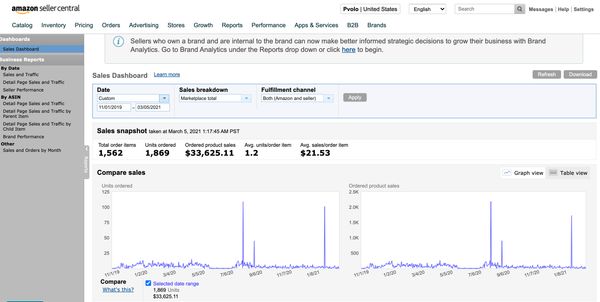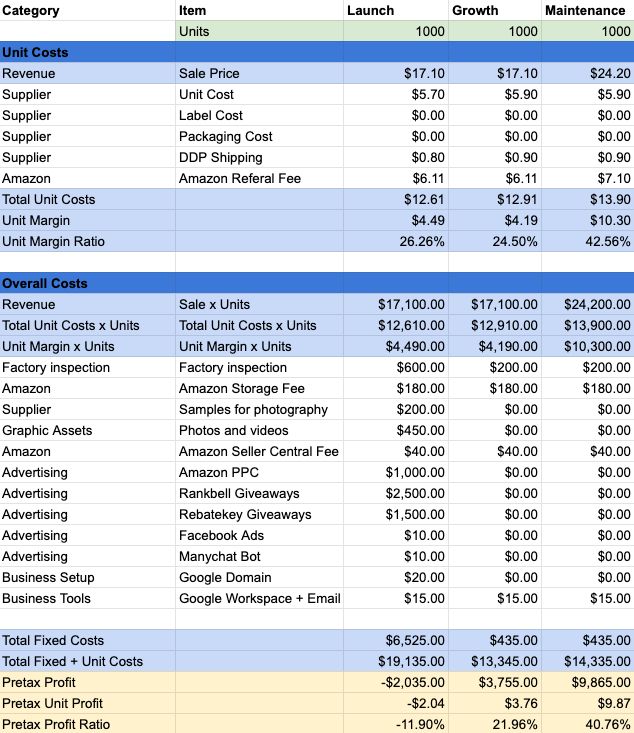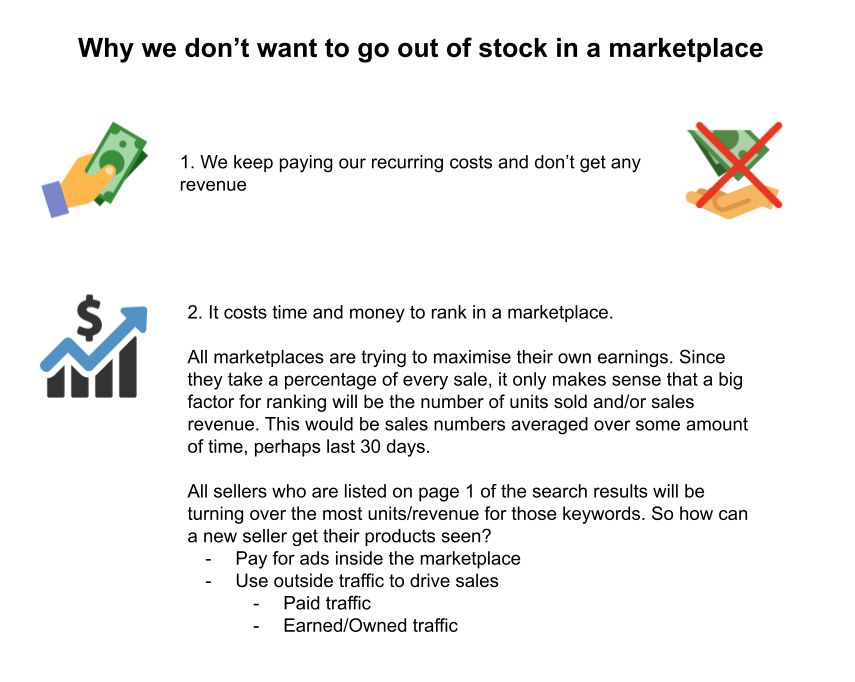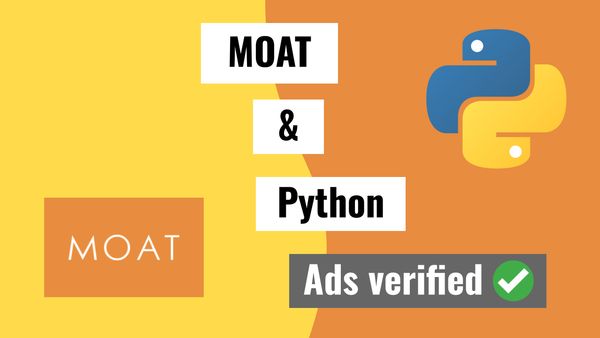
9 lessons from starting and failing an Amazon ecommerce business
Published 2021-03-05
The Short Version
In May 2019 I started an Amazon FBA business, with starry eyes and lots of learning to do, I set out to see what this ecommerce game was all about. Fast forward to March 2021 and the business is almost shut down. At the time of writing, I’ve sold 1869 units with $33,625 in Revenue. Doesn’t sound too bad you might think, that’s some healthy side income you might say, the short answer is not really.

I decided in September 2020 that this business was to be shut down or sold. The main reason for the early exit is that product-founder fit is very poor between me and this business. If you read on I'll show you my brand, my numbers, my thought process and my main wins and losses. It will be a form of closure for me to reflect and hopefully interesting for you since I still have some product in stock, you can see my actual listings and troll me if you like 😂
Lesson #1
Product-Founder fit matters.
If Product-Market fit determines if your product will survive in the wild, Product-Founder fit determines if your product will survive your own mind. There’s a saying that most businesses die from suicide rather than homicide. Which means the founder(s) killed the business before the competition had the chance to do so.
The reasons my business is a poor product-founder fit and the reason I’m exiting:
- I’m not in tune with my niche
- I don’t think the physical products space is a small bet to take as a business venture
- I’m having so much fun on this journey into digital products
I would summarise this journey as a time travel forward in personal growth. I’ve learned so much, met some inspiring people and will build upon these lessons and try another venture in the digital space 🧐
Entrepreneurship is just accelerated personal development
My products:
- Pvolo Smell Proof Bag US listing
- Pvolo Smell Proof Foil Baggies US listing - sadly no longer exists
- Pvolo Smell Proof Bag AU listing
The Long Version
My first try at being an Entrepreneur -- Kind of random
A day in March 2019, when I had a catch up lunch with a friend/mentor. We ate steaks at a pub in North Sydney and he introduced the idea of selling products online. I had never considered selling products online before, so I was not completely sold. But greed was kicking in and the idea of passive income sounded promising. My friend and some of his friends had tried Amazon FBA (Fulfilled By Amazon) with limited success so least that much success seemed achievable. The numbers seemed to work out and I went home to learn more. Having a bit of entrepreneur’s optimism/naivety in me, after a few of days of research I had convinced myself to give Amazon FBA a try, I was so excited to start my browser tabs were full of searches, “how to research relevant keywords”, “how to find trustworthy suppliers” and more. Note: Amazon FBA is a type of business where you sell your goods on Amazon.com and use Amazon’s services to do fulfilment, shipping and returns. You buy products for less, send them to Amazon’s warehouses, then sell them for more on Amazon.com.
Knowing so little about being an entrepreneur my starting point was a strategy/method (Amazon FBA). Looking back now the actual first is step is problems and customers.
Lesson #2
A generic framework for a startup company
- Problems and customers
- Making the numbers work. How to monetise and personal preferences
- Executing the plan
- Feedback, improving and adapting
- The exit strategy
Expanding on the generic framework. In step 1. we first want a deep understanding of problems that people have. Too shallow an understanding and we’ll likely run into issues later. At the same time we want to understand the group of people that will be our customers. This is called the niche or audience, and it’s often easier to start with a more specific group of people and expand towards a larger and more general group of people. Think about the old saying that a product for everyone is a product for no one.
In step 2. we verify there’ll be a payoff for our efforts. This is the strategy stage, what particular method we’ll use to make the dollars (or relevant currency). Some examples are Amazon FBA, Drop Shipping, Affiliate Marketing, SaaS, Blogging, YouTube, Podcasting, Writing a book, Selling Courses, Opening a Shop, TikTok, etc. The monetisation method will tie in with understanding our customers, as certain people will tend to be found in certain places/platforms more often than others. The last bit of monetisation is understanding your own preferences, in an ideal case you like most of the day-to-day tasks you do. This will greatly help with the endurance of your business, especially during bad days. I like the saying “peak motivation is when you’re just good enough to succeed”. This says that you should be attempting things that you can complete and not something that you’ll almost certainly fail. Additionally it speaks to motivation regarding things that don’t give you mental stimulation. If there’s something easy to do and also really plain, it will be a chore.
Peak motivation is when you’re just good enough to succeed
I believe step 3. is showing up every day and doing the work. If things aren’t moving in the right direction, you have to question what work you’re doing day to day. Perhaps you’re not working on the most critical tasks or tasks with the highest payoff. A handy quote here “show up every day for 2 years and it’ll happen”, it’s vague enough for you to question, what will happen? Some level of success/learning of course! It’s also a good rule that 1-2 years is a pretty good amount of time to be trying an entrepreneurial venture. Anything shorter is probably not a committed enough go.
Show up every day for 2 years and it’ll happen!
Step 4. is measuring your results and understanding what elements of your business are bringing in meaningful results. Deciding what success looks like will allow you to succeed and fail. Here are some handy formulas that we should know.
Eqn1. Yearly Revenue = (Existing Customers + New Customers - Lost Customers) x (Average Yearly Spend per Customer)
Eqn2. New Customers = Traffic x Conversion Rate
Eqn3. Average Yearly Spend per Customer = (Average Spend per Sale) x (Number of Sales per Year)
These three equations give us an easy way to think about the right questions to ask about Revenue. As an example, from Equation 1, how can we increase new customers? How can we reduce lost customers (churn)? How can we increase the average spend per customer? Once you have these in mind, you can make better decisions to improve them.
Step 5. Four common ways a business can be exited:
- Sell it to another company/entity
- Sell it on the public markets (IPO)
- The business dies and the remainder of the assets are salvaged
- Hold on to it and live off the cash -- actually not an exit, but this is still an exit strategy until one of the above 3 things happen.
I’ll explain my brand, products and thought process in the context of these 5 steps next.
The life and death of the Pvolo brand
My brand is called Pvolo, pronouced “volo” with a silent “p”, but puh-volo also works haha. We’re a cannabis lifestyle brand selling two products on Amazon. One smell proof bag and one box of smell proof foil bags.
We had fun at this photoshoot, there was a frame and a lot of fishing line holding the smell proof bag in place. The bag itself is the size of a small handbag.

The foil bags are sealed and help keep the cannabis smell inside.

My thought process behind the brand was to "sell shovels during the gold rush". Where the gold rush is the legalisation of cannabis in the United States. Choosing this niche was actually a pretty good choice. I witnessed growth in keyword search volume, revenue and competitors since I've started. From May 2019 to Sep 2019 I saw keyword volume rise 3x and the average revenue of the top 10 products rise 1.6x. So in that way, I would recommend riding trends early. Sadly I never made it into the top 10 products 📉
Lesson #3
Positioning yourself around a trend and getting in early is a good way to ride a wave
Current trends that might be worth riding: ecommerce, climate change, cryptocurrency/blockchain, AI/robotics, Internet of Things (IOT), 5G, Smart home/city, Digital health, AR/VR, electric vehicles, cost of healthcare/education and cannabis legalisation. The last two being more US centric.
The way I picked my first product, the smell proof bag to sell was via keywords. I wanted to pick a product to sell that had a moderate amount of search volume, moderate amount of revenue and moderate competition. Using Helium 10 (a software tool for Amazon sellers), I discovered the keyword “stash box”, not knowing what a stash box was I started researching. I found mostly wooden boxes that were used to hold cannabis and related gear. I decided I didn’t want to sell a wooden box because I thought it might break more easily in transport and might need to pass through some kind of regulatory body regarding bringing wood-born pests into another country. “Smell proof bag” was a similar keyword where the products were made of polyester and should be as simple as selling backpacks, which it was, there was no regulation issues and zero units got destroyed in transit.
To recap, I decided to start a business on a strategy (Amazon FBA), then pick something to sell almost at random based on keyword search volume (smell proof bags). Not how I would do it again 😂
- What problem was I solving? Keeping the cannabis smell inside the bag
- How good are these bags at doing this? Better than a regular bag and worse than a sealed glass jar. All the polyester smell proof bags work the same way, they have activated charcoal layers in the bag, where activated charcoal absorbs smells
- How much do I understand the problem of keeping smells inside the bags? Not enough to make something that is on par with a sealed glass jar
- How much do I understand the people who are buying these bags? A little, I talked to some friends in the know, but I myself had little idea.
On my journey I connected with someone I can only describe as a brand ambassador, his name is Nicky. I couldn’t hope to meet someone nicer actually. He reached out to me on Instagram and said he wanted to buy 10x bags, but first wanted to see a sample. I thought he was some kind of scammer, but me being new, I thought that it’s pretty cheap to send a guy a free bag to try, even though I didn’t believe his story of wanting to buy 10x bags. Turns out Nicky lives in Canada and is very much in the cannabis community. After a few conversations he says something that triggers a lightbulb moment for me. He suggests that I make a bigger bag so he can put all his cannabis gear inside the bag. 80% of the top 10 selling smell proof bags are around the size of a large lunchbox or a toiletries bag. I made a choice to make a small handbag sized bag as a differentiator, I thought, 80% of the bags are large, I’ll make mine small for the minimalists out there. Turns out this size choice hurt the product a lot, all because I didn’t start from the problem and customers. Some typical gear that a cannabis user might carry: cannabis in a foil bag or little metal/glass container, grinder, pipe, lighter, papers, tray, gum/mints, vapes, phone and sunglasses. My bag could fit maybe half the gear. Despite my bag being a non-ideal size, Nicky has an Instagram channel with a few thousand followers, and he tags the Pvolo business Instagram account in relevant posts a handful of times a week for a few months. It’s hard to determine how many sales he would have driven, but I had people reach out to me asking if I could sell the bag in Canada and the UK, which I’m sure was because they saw Nicky’s Instagram account. I didn’t pay him and only gave him a free bag, truely too nice of a person to randomly meet online. I don’t imagine this is too common, and probably not repeatable, but meeting nice random people on the internet is possible. My advice is be skeptical but give people a chance, kind of useless information right?! 😅
Lesson #4
Be skeptical but give people a chance if the cost is low enough
Some random highlights:
- Seeing the product prototypes in my hand for the first time\ Real world testing of the bags and making improvements is very satisfying. I can see why being a Product Manager might be a fun job
- Making my first sale\ Someone paying you money for something you created, I felt surprised and accomplished 😮 I remember saying to my wife “why would someone buy this random thing I made? It has no reviews or anything”
- Ranking on page 1 for relevant keywords on Amazon for a few months
- Having a business customer purchase 100 units in a single check out
- Having Trademarks approved in Germany in 13 days\ This was a little hack that is no longer relevant. Amazon give you extra features (called A+ content, which comprises of posting videos and an extra picture section) if your product is trademarked. Trademarking in the USA takes around 9-12 months. Trademarking in Germany was insanely quick and these trademarks were accepted by Amazon at the time to unlock A+ content.
Some random low points:
- Going out of stock and paying $2,155 in giveaways to rank again\ I’ll explain more about ranking in the numbers section
- Spending $16,000 on a business coach\ My experience here is that I was given some good-average advice, but nothing mind blowing. I was coached for a year remotely and my belief now is that advice is easy to come by. Instead of this I’d recommend becoming a contributing member of a community and learning from peers and people who are ahead of you in their journey. I’m sure there’s some scenario’s where a business coach would be very relevant, but I’m not sure what that is yet
- Quality control issues with the bag’s lock\ The two number combination lock was a key feature of my bag, there was around 50 units (5% of my order) that jammed shut and couldn’t be opened. These customers complained and returned the bags. I was lucky here because my factory in China agreed that they would refund me for every faulty bag. A good tactic here is to ask if you can send them a replacement product for free, this hopefully keeps them from writing bad reviews
Lesson #5
Learn and teach in a community of peers
You’ll gain a lot more and it will be much cheaper than hiring a business coach
The numbers -- unhiding some common mistakes
The following spreadsheet refers to the Pvolo Smell Proof Bag. I used this to create an estimate of profits and understand where my costs would go. It’s slightly simplified in terms of my actual estimates, just so I can more easily screenshot it. Feel free to copy this and use it for yourself Amazon FBA Numbers Snapshot. Before you dive into using it, I’ll explain what’s happening here and some hidden truths.
If you look at the columns Launch, Growth and Maintenance. They are assumed to be monthly numbers, so selling 1000 units a month (this turned out to be too lofty a goal for my product). This also lines up with some of the Overall costs that are monthly fees, such as the Google Workspace + Email cost ($15/month) and Amazon Seller Central fee ($40/month).

The snapshot and the marketplace
The Launch column we’ve squashed together our setup costs such as graphics, photography and ads. These are one-offs for me and I didn’t plan to spend money on them after the initial time.
The Growth period is when your product is gaining traction and trying to find price equilibrium. You can test raising and lowering your price here, making note of how price affects sales. Some niches are much more price sensitive than others.
The Maintenance period is when your product has found its natural selling price and continues to do so for some time. You can see that my estimate for Sale Price in the Maintenance stage is higher than Growth. This is wishful thinking, what ecommerce product ends up costing more over time? Perhaps if a new model is released, but typically the same model of product doesn’t increase in price. What actually happens, especially in a marketplace is that prices decay over time. The two main reasons this happens is:
- The unimaginative competition simply copy the top product in a niche and sell almost the same product at a lower cost. If they are successful at annoying the seller of the top product, the top seller will lower their price. As a result the other sellers will likely lower prices to stay competitive.
- The imaginative competition will take the top 10 products. Assess the best features of each and release a better product. Hopefully the better product can hold a higher price, but there are bound to be competitors that will build a better product and sell at a lower price.
Thinking about points 1 and 2, I’ve pretty much described products and capitalism.
Lesson #6
Prices of products in a marketplace decrease over time. A likely result of this is that even a non-perishable product has an expiry date. The expiry date arrives when the product is no longer profitable.
The product might not be profitable if prices keep falling and costs remain the same and/or the competition has innovated so far ahead that there’s no longer any demand for your product. For a physical product my guess is that 2-3 years is enough for a product to start looking for an expiry date.
The next step in this line of thinking is that you must keep releasing new products if you want to stay in the products game. It’s an obvious statement that also says, it would be exceedingly difficult to enter the products game and retire on one product.
The next important thing to keep in mind regarding marketplaces is to not go out of stock. When the sales stop, we find two big downsides.

As an easy example, if we sell 300 units in 30 days and have our product listed on the bottom of page 1. We go out of stock for 10 days and the ranking algorithm takes a data point. That’s now 200 units sold in 30 days. Perhaps someone who was ranking no page 2 with 250 units sold in 30 days is now in your old spot. You might need to pay for some traffic to make up those 100 lost sales. Or if you do nothing, maybe your product is now ranked on page 2 and your sales are deflated until otherwise.
Lesson #7
Plan to not go out of stock, it will be costly
The timeline of cash flow and stock
It’s a bit too tedious explaining this concept via typing, so watch the video for a full explanation (when I finish it). I’ll explain some of the more type-able things I noticed below.

The timings that I highlight above are from my Smell Proof Bags, rounded to the nearest week. Taking 12 weeks or 3 months from buying stock to getting paid for that shipment of product means you might need more cash than you think to keep the company afloat. What I had in mind when I started was to input some money, say $20,000 into the company then the company can fund itself without needing me to input more money. What ended up happening was that my product never took off, so my projections were far off and I never ended up breaking even.
Lessons from the timeline video explainer, timeline projections can help you visualise:
- When to order new stock, so that we don’t go out of stock
- Seasonality and planning with important times of the year (e.g. Q4 and Chinese New Year)
- The time taken for the business to be self sufficient (require no more outside money)
- Where does growth come from? Outside money (your own, investors or debt)
As a small business owner, we should try to be profitable. One key measure to pay attention to is the time to break even, the amount of time to recoup the money you’ve spent in the business. From my video (not yet done), you can see that an Amazon FBA business with conditions similar to mine (unit cost around $5-6) is likely going to take >1 year to break even in an ideal scenario. Combine this with the expiry date of a product that is say 3 years, we have 2 years of profits to take from this product.
Additionally the amount of money required to start (~$20k) is a fairly big bet for a lot of first time entrepreneurs.
As such my conclusion is: if your customer’s problem(s) can be solved with a physical product, use the snapshot and timeline to frame the time and costs involved. In a worse case scenario, if my business was to get zero sales, I would be out of pocket $20k. In a best case scenario I would have $3755 (profit per month) x 12 x 2 (two years) - $90k profit over 3 years. The final result will likely be in between. Which raises the question. Is there a less risky way (a way where I don’t lose $20k) to earn an extra $30k a year? Perhaps working on getting a promotion at work doesn’t seem that difficult anymore.
Lesson #8
Ask yourself: Is there another way to earn $X / year without losing $Y?
Not losing money is a key part of being bootstrapped entrepreneur
Advice and the two businesses you could be running as an Entrepreneur
A profit first business vs a growth first business.
A profitable business is one that anyone can understand, Business X earns $100 and pays out $80 in costs, then is left with $20 profit. This is what we should aim for as bootstrapped (self-funded) entrepreneurs.
A growth first business might be unprofitable at first, earn $100, pay $150 in costs and have -$50 profit. How does the -$50 get paid? Debt/loans or investors. The goal is that one day it becomes profitable, but first taking market share (acquiring customers) and growing revenue. Two famous examples are Uber and Amazon. Uber is still a loss making business and Amazon took around 10 years to turn a profit. It probably sounds too obvious, but if you’re planning to start a growth first business, find funding and lose someone else’s money during the unprofitable stage. This is a different business to run than a profit first business. As the entrepreneur who is funded by outside money, you’ve got a timer on your back (your cash runway) and a boss to answer to (venture capitalists, investors, banks, etc).
There’s plenty of advice floating around the internet. Where a lot advice will come from people who have built massive companies funded by venture capital (VC) money. Know what advice will be applicable to your situation.
In this blog post, you know that I’m a first time entrepreneur, who self-funded a physical products business and failed. Take my lessons and do a better job at being a self-funded entrepreneur than me.
Lesson #9
Learn from people who are less than 3 years ahead of you, they should still remember the specific struggles you’re going through.
Appendix
Lesson #1
Product-Founder fit matters.
If Product-Market fit determines if your product will survive in the wild, Product-Founder fit determines if your product will survive your own mind. There’s a saying that most businesses die from suicide rather than homicide. Which means the founder(s) killed the business before the competition had the chance to do so.
Lesson #2
A generic framework for a startup company
- Problems and customers
- Making the numbers work. How to monetise and personal preferences
- Executing the plan
- Feedback, improving and adapting
- The exit strategy
Lesson #3
Positioning yourself around a trend and getting in early is a good way to ride a wave
Current trends that might be worth riding: ecommerce, climate change, cryptocurrency/blockchain, AI/robotics, Internet of Things (IOT), 5G, Smart home/city, Digital health, AR/VR, electric vehicles, cost of healthcare/education and cannabis legalisation. The last two being more US centric.
Lesson #4
Be skeptical but give people a chance if the cost is low enough
Lesson #5
Learn and teach in a community of peers
You’ll gain a lot more and it will be much cheaper than hiring a business coach
Lesson #6
Prices of products in a marketplace decrease over time. A likely result of this is that even a non-perishable product has an expiry date. The expiry date arrives when the product is no longer profitable.
The product might not be profitable if prices keep falling and costs remain the same and/or the competition has innovated so far ahead that there’s no longer any demand for your product. For a physical product my guess is that 2-3 years is enough for a product to start looking for an expiry date.
Lesson #7
Plan to not go out of stock, it will be costly
Lesson #8
Ask yourself: Is there another way to earn $X / year without losing $Y?
Not losing money is a key part of being bootstrapped entrepreneur
Lesson #9
Learn from people who are less than 3 years ahead of you, they should still remember the specific struggles you’re going through.
Related Posts

Connecting to Google BigQuery using Python
Published 2021-01-05
Google BigQuery is a good choice of cloud database if your data is being used for analytics and doesn't require fast writes. Let's explore how to perform CRUD (Create/Read/Update/Delete) actions with Python 🐍
bigquerypythonapisql
How to pull data from the MOAT API using Python
Published 2021-01-04
Ad verification data can be used to confirm if your ads are really being seen or not. MOAT is one of the major players and here is how to use their API.
moatpythonapi